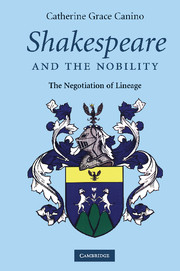Book contents
- Frontmatter
- Contents
- List of illustrations
- List of appendices
- Acknowledgments
- Introduction: the nobility and genealogy
- 1 The Staffords (Dukes of Buckingham)
- 2 The Dukes of Suffolk
- 3 The Nevilles (Earls of Warwick)
- 4 The Talbots (Earls of Shrewsbury)
- 5 The Cliffords (Earls of Cumberland)
- 6 The Stanleys (Earls of Derby)
- 7 The gentry (William Lucy, Lord Saye)
- Conclusion
- Appendices: genealogical charts
- Index
4 - The Talbots (Earls of Shrewsbury)
Published online by Cambridge University Press: 03 July 2009
- Frontmatter
- Contents
- List of illustrations
- List of appendices
- Acknowledgments
- Introduction: the nobility and genealogy
- 1 The Staffords (Dukes of Buckingham)
- 2 The Dukes of Suffolk
- 3 The Nevilles (Earls of Warwick)
- 4 The Talbots (Earls of Shrewsbury)
- 5 The Cliffords (Earls of Cumberland)
- 6 The Stanleys (Earls of Derby)
- 7 The gentry (William Lucy, Lord Saye)
- Conclusion
- Appendices: genealogical charts
- Index
Summary
It is generally accepted that Shakespeare's portrayal of John Talbot in 1 Henry VI is a tribute to Talbot's descendant, George Talbot, sixth Earl of Shrewsbury, who died around the same time 1 Henry VI was composed. Although some critics argue that Shakespeare was less than enthusiastic about the character, most agree that Talbot is a flat but nonetheless exemplary figure, the last champion of English chivalry and patriotism, the last English “hero” before Henry Tudor. Alice-Lyle Scoufos has suggested that this conspicuously laudatory portrayal is in fact a much needed accolade for the beleaguered Elizabethan Talbots. As Scoufos explains, George Talbot was defamed as an overly fond “guardian” and perhaps co-conspirator of Mary, Queen of Scots. At the urging of his estranged wife, Bess of Hardwick, Queen Elizabeth temporarily relieved Shrewsbury of his post as the Scottish queen's guardian in 1584. Although he was eventually restored to his duties, the rumors of his possible disloyalty plagued him until he died, embittered and alienated from the court, in 1590. Scoufos has suggested that Lyly's Endymion was an allegory of Shrewsbury's relationship with Mary Stuart, and that Shakespeare created the character of Talbot to counter Lyly's negative portrayal. This is a provocative suggestion by Scoufos; however, she neglects to point out that Shakespeare's creation is not his own.
- Type
- Chapter
- Information
- Shakespeare and the Nobility , pp. 128 - 149Publisher: Cambridge University PressPrint publication year: 2007

